Try Default

See how revenue teams automate revenue operations with Default.

Key Takeaways
- Chili Piper works for teams focused purely on speed-to-lead — especially when booking needs are urgent and rules-based. But as complexity grows, so do costs and integration overhead.
- HubSpot fits if you’re a lean team already using HubSpot CRM and need basic scheduling without external tools or advanced routing.
- Default is built for RevOps and GTM teams ready to orchestrate their full inbound funnel — with real-time enrichment, routing, scheduling, and CRM sync all in one system.
- At scale: HubSpot stays affordable, but limited. Chili Piper adds cost and operational overhead. Default offers predictable pricing and full control — no duct tape required.
50 % of deals go to the vendor that responds first. And you're 21 times more likely to qualify a lead if that response happens within five minutes.
For RevOps and GTM teams, speed-to-lead isn’t a "nice-to-have"—it’s mission-critical. Miss by minutes, and pipeline slips away.
So, which tool actually keeps your funnel moving: Chili Piper or HubSpot?
- Chili Piper is built for high-volume inbound, instant-booking workflows, and complex routing logic.
- HubSpot works best for simple scheduling, especially if you’re already deep in the HubSpot CRM.
If all you need is a meeting link, either tool works.
But most GTM teams need more.
That’s where Default comes in.
It’s not just a scheduler or router — it’s a visual orchestration platform built for full-funnel control. From form fill to booked meeting to CRM sync, Default connects every step in one drag-and-drop workflow.
In this guide, we’ll break down Chili Piper and HubSpot head-to-head — pricing, features, and where they fall short. Then we’ll show how Default replaces that stack with a faster, more scalable system designed for RevOps control.
Chili Piper vs HubSpot — Quick Comparison
.png)
Chili Piper is built for fast-moving GTM teams that need to route inbound leads by territory, rep, or product — instantly. If your funnel depends on real-time booking, round-robin logic, or multi-rep handoffs, it delivers.
But only if your RevOps team has the bandwidth to set it up and keep it running.
It’s a strong fit for:
- B2B teams running performance-based lead assignment
- Companies using Salesforce + manual enrichment tools
- Teams prioritizing speed-to-lead above all else
It’s not a lightweight scheduler. Without technical oversight and a well-maintained CRM, you’ll hit setup friction fast.
Who is HubSpot useful for?
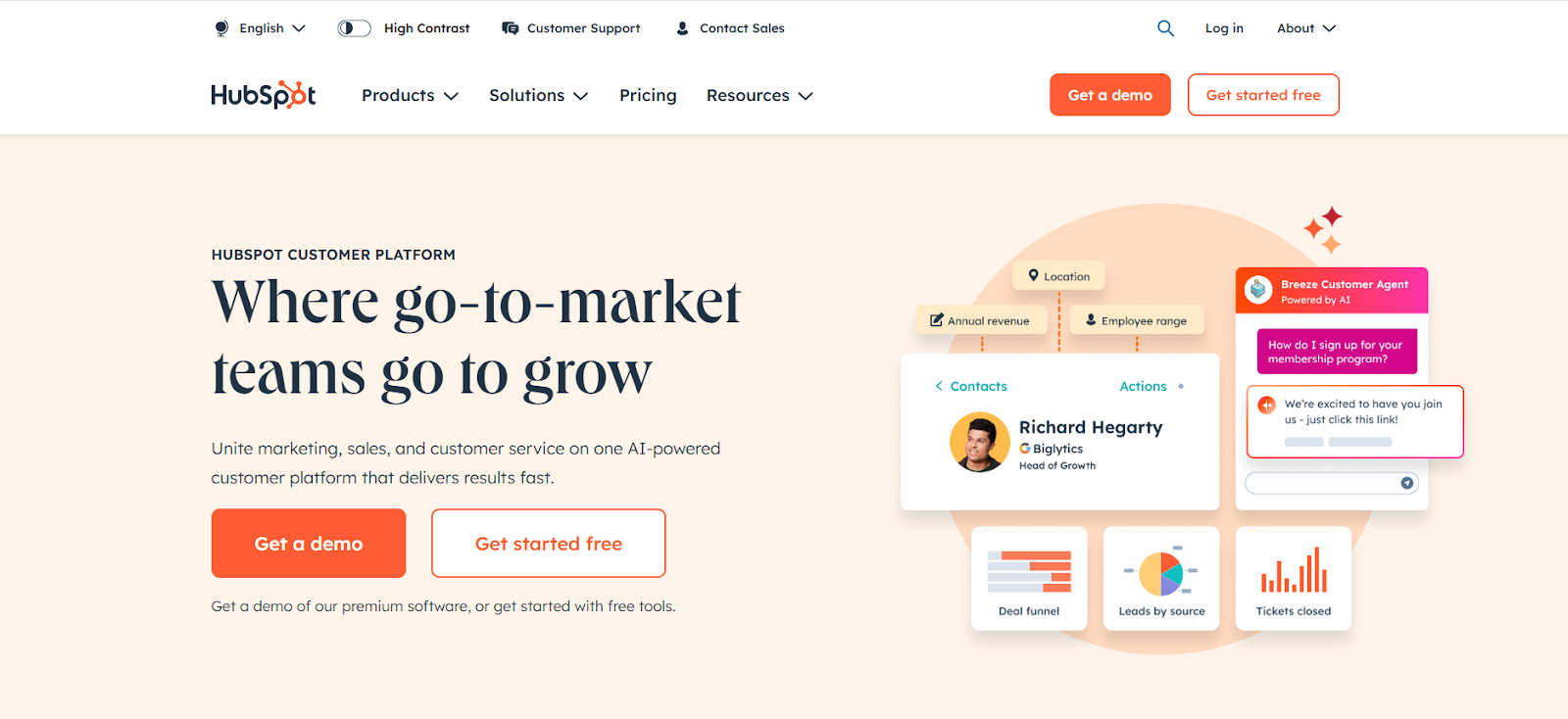
It’s a strong choice when:
- Your team operates fully within the HubSpot ecosystem
- You don’t need ownership-based routing, fallback flows, or enrichment
- You’re optimizing for speed-to-setup, not long-term workflow depth
But once complexity grows — product lines, multi-rep teams, object logic — HubSpot’s scheduler hits a wall fast. No routing conditions. No enrichment triggers. No built-in handoff logic.
Default: an alternative to Chili Piper and HubSpot
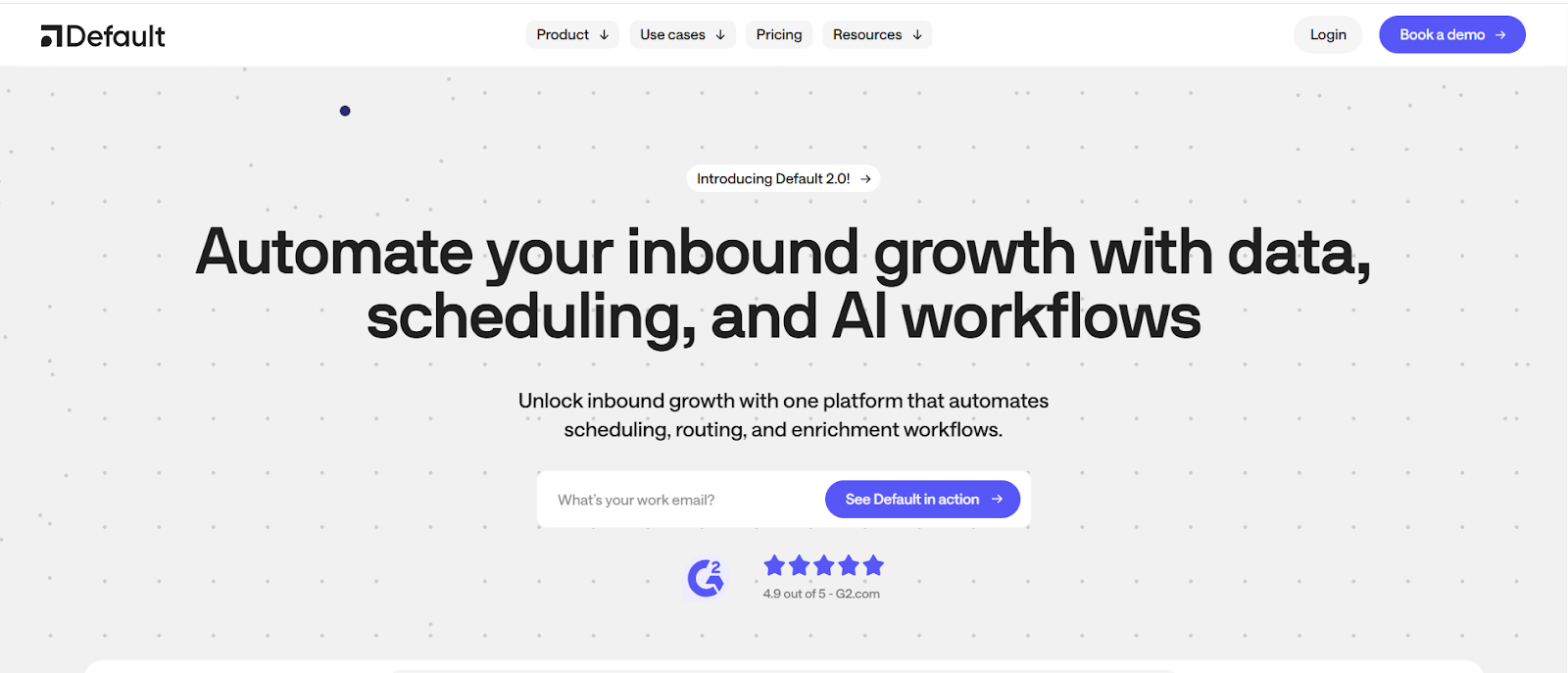
Default isn’t just a scheduler or router. It’s sales workflow software built for RevOps teams that are done stitching together enrichment APIs, CRM workflows, and meeting tools just to move a lead.
Instead of bouncing between disconnected platforms, Default gives you one visual canvas to run your entire inbound funnel — from form fill to booked meeting to CRM sync.
With Default, you can:
- Enrich, de-dupe, and score leads in real time — before routing happens
- Route based on any CRM field, firmographic trait, or buyer behavior
- Instantly book meetings, with fallback logic for no-shows or conflicts
- Push clean, enriched data directly into your CRM — automatically
All in a drag-and-drop interface that mirrors your funnel logic, not a black box you have to guess your way through. No engineering required. Just fast, intelligent handoffs that actually scale.
Pricing comparison
Try Default for your entire inbound funnel — not just meetings.Book your interactive demo today.
Price: what are you really paying for?
For RevOps teams, price isn’t just about license fees. It’s the total cost of running your inbound funnel — the add-ons you bolt on, the time your ops team spends maintaining workflows, and the leads you lose to broken logic.
Here’s how Chili Piper, HubSpot, and Default compare — not just in dollars, but in downstream impact:
Chili Piper
- $30/user/month for each product (Concierge, Distro, Handoff, Chat)
- Platform fee scales with inbound volume: $150–$1,000/month
- Most orchestration features require add-ons or separate licenses
- Enrichment is not included — you'll need tools like Clearbit or ZoomInfo
- Support varies; advanced help gated behind higher tiers
Translation: By the time you’ve built your funnel, you’re juggling 3–5 products and a variable platform fee — just to route and book correctly.
HubSpot
- $0–$15/user/month on Free or Starter
- Sales Hub Pro: $90–$100/user/month + ~$1,500 onboarding
- Sales Hub Enterprise: $150/user/month + ~$3,500 onboarding
- Routing is basic — tied to CRM ownership
- Minimal enrichment, no fallback logic, limited object support
Translation: It’s cost-effective if you stay inside HubSpot’s ecosystem — but brittle if you need real routing, data, or automation depth.
Default
- $500/month flat platform fee
- $45/user/month for routing + scheduling
- $20/user/month for scheduling-only seats
- Enrichment is built-in: waterfall, dedupe, and usage-based scaling
- All features included — no add-ons, no surprises
Translation: You get full-funnel control in one system — at a predictable cost that doesn’t balloon as complexity grows.
Ease of use: how fast can your team go live?
For RevOps and GTM teams, capability means nothing without usability.
If your team needs weeks of admin time, dev tickets, or playbook rewrites just to launch basic routing, you’re not moving fast — you're stuck babysitting tools.
Here’s how Chili Piper, HubSpot, and Default compare on setup speed and operational usability:
Chili Piper
- Setup requires configuring multiple disconnected products — Concierge, Distro, Handoff — each with its own admin panel
- Routing rules, fallback logic, and calendar calibration are powerful but complex
- Expect a steep learning curve unless your RevOps team is highly experienced
- Orchestration often involves manual API stitching and support from sales engineers
Verdict: Feature-rich, but fragmented and heavy. Rollouts take time, especially across multi-team GTM flows.
HubSpot
- Scheduling is plug-and-play inside the CRM — no setup needed for simple use cases
- No routing builder, fallback logic, or object-aware triggers
- Great for solo reps or basic handoffs, but logic complexity caps out fast
- Admin overhead is low — but so is workflow flexibility
Verdict: Ideal for fast starts with minimal effort — not for teams scaling beyond basic lead flows.
Default
- Visual builder for end-to-end funnel setup — form capture → enrichment → routing → booking → sync
- No dev work, no bolt-ons — everything lives in one canvas
- Bundled Slack-first onboarding, with RevOps-native CSMs who understand GTM structure
- Launch full workflows in days, not weeks — with complete logic visibility and version control
Verdict: Built for speed and scale — Default lets your team launch confidently without ops debt or engineering lift.
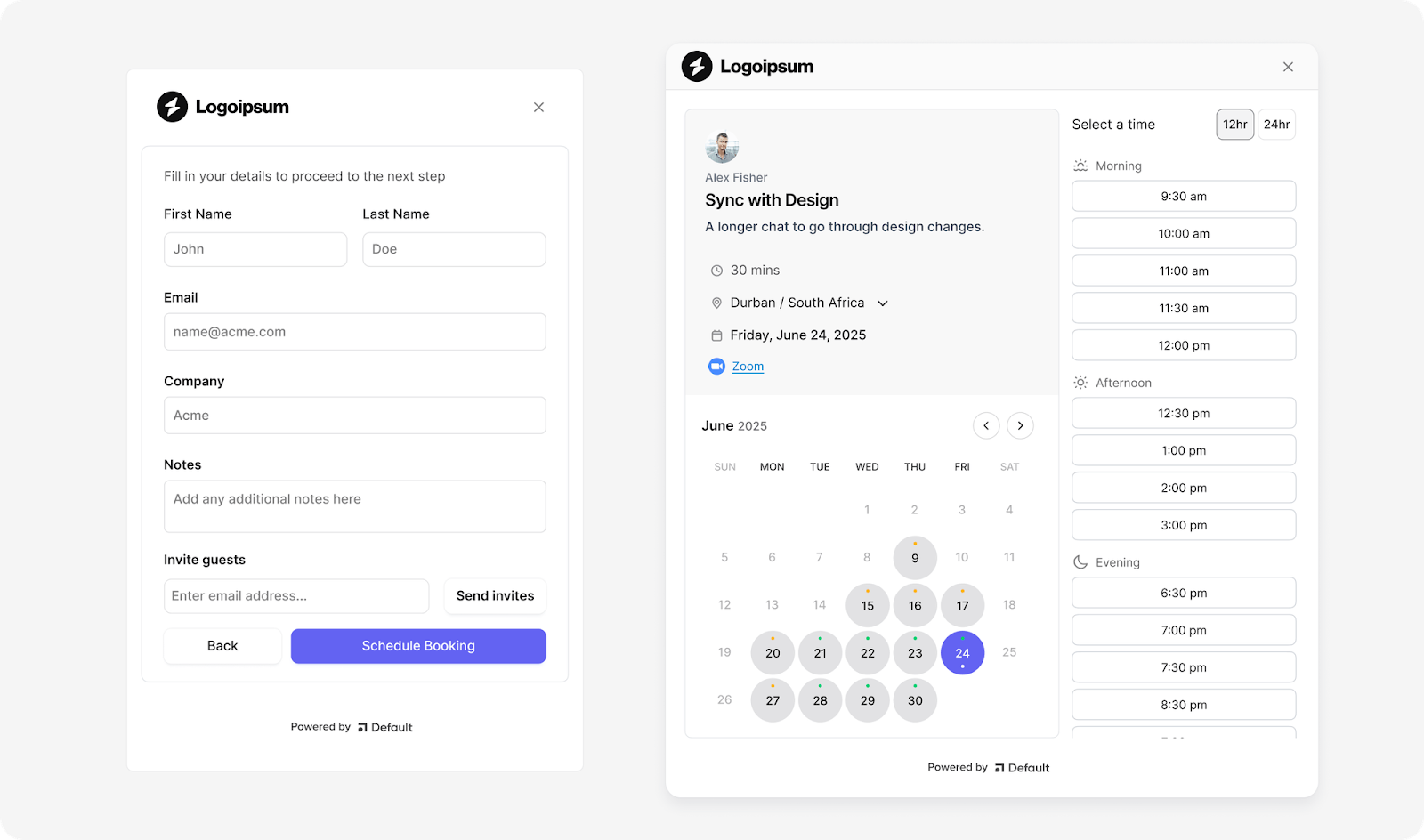
Customer support: how fast can you get unblocked?
When a lead doesn’t route, a calendar breaks, or a record misfires in your CRM — it’s not a minor issue.
It’s pipeline on pause.
For RevOps teams, support isn’t about closing tickets. It’s about resolving critical blockers before they cost revenue.
Here’s how Chili Piper, HubSpot, and Default stack up:
Chili Piper
- Email and Slack support available, but gated by tier
- Dedicated CSMs are reserved for high-paying enterprise plans
- Documentation is solid, but most troubleshooting is left to in-house ops
- Support varies across products (Concierge, Handoff, Chat), adding complexity
Verdict: Support is reactive and fragmented unless you’re on a top-tier plan — expect to self-navigate when it matters most.
HubSpot
- Support scales with plan: free plans get community + email, paid plans unlock chat and phone
- HubSpot Academy and Help Center are strong for marketing/sales ops — but not built for complex GTM routing
- No real-time handoff support or enrichment strategy help
Verdict: Great self-serve for general use — but lacks RevOps context and strategic unblockers.
Default
- Slack-first onboarding with GTM-aware CSMs from day one
- Support team understands CRM logic, enrichment, ownership rules, and routing flows
- Issues resolved in context — not with scripts, but with real design guidance
- Response times are fast, and onboarding is proactive — not reactive
Verdict: Designed for RevOps — not just support, but strategic unblockers who understand your full workflow.
Integrations: how well does it fit into your GTM stack?
For RevOps teams, integrations aren’t just about ticking boxes.
They’re the foundation of your inbound engine — syncing data across CRMs, enrichment providers, calendars, and comms tools to ensure leads route fast and accurately.
If your tool can’t sync, trigger, or write back cleanly, you’re creating routing errors, dirty records, and dropped pipeline.
Chili Piper
- Native integrations with Salesforce, HubSpot, Google Calendar, Zoom, Slack, Outreach, and Salesloft
- Enrichment is external — requires additional tools like Clearbit, Apollo, or ZoomInfo
- Conditional logic often requires Zapier or custom API work
- No unified orchestration layer — logic lives across multiple products
Verdict: Good surface-level integrations — but orchestration still requires duct tape and outside tools.
HubSpot
- Natively embedded into the HubSpot CRM and marketing suite
- Calendar scheduling works out of the box — but routing only works inside HubSpot
- No native support for Salesforce, external enrichment, or object-aware automation
- Very little flexibility for multi-tool GTM stacks
Verdict: Great if you're all-in on HubSpot; inflexible if your GTM stack is broader.
Default
- Native integrations with Salesforce, HubSpot, Attio, Google Calendar, Slack, Zoom, Segment, and more
- Built-in real-time enrichment layer — no third-party tooling required
- All integrations live inside the workflow canvas — used as triggers, inputs, and logic conditions
- Supports pre-routing enrichment, CRM write-back, rep calendar sync, and behavior-based routing
Verdict: Default isn’t just integrated — it’s orchestrated. Every tool connects through logic, not just data sync.
Common complaints
Even solid tools come with friction — especially when you push them beyond their ideal use case. Here’s where RevOps and GTM teams consistently hit blockers with Chili Piper and HubSpot.
Chili Piper
- Steep setup curve: Configuration for round-robin rules, fallback logic, and CRM sync often requires technical help, delaying time-to-value.
- Support behind a paywall: Full support and CSM access are reserved for enterprise tiers, leaving lean teams under-resourced during implementation.
- Hidden complexity cost: As you scale, you often end up relying on multiple add-ons (Clearbit, Zapier, Slack workflows) — increasing failure points and cost.
Impact: Many teams end up managing 3–5 tools just to route and book meetings — or constantly fixing handoff issues when logic misfires.
HubSpot
- Limited routing control: Can’t handle territory rules, ownership conditions, or deal-stage triggers, making it hard to scale beyond solo scheduling.
- CRM lock-in: It works beautifully — as long as everything lives in HubSpot. The moment Salesforce or enrichment enters the picture, friction rises fast.
- No fallback or object logic: No-shows, reassignment needs, or multi-role routing are out of scope, leaving GTM teams to plug gaps manually.
Impact: Ops teams often resort to workarounds, Zapier hacks, or external schedulers — just to cover basic routing use cases.
How to choose the best scheduling software
Choosing a scheduling platform isn’t just about booking links — it’s about how well a tool supports your entire GTM motion. Here are three key capabilities to look for when evaluating scheduling and routing tools.
1. Conditional lead routing that reflects real GTM logic
If your team supports multiple regions, product lines, or sales roles, static round-robins won't cut it.
You need logic that can route leads based on:
- Firmographic traits (e.g. industry, employee count)
- Form input (e.g. "What are you interested in?")
- CRM fields (e.g. ownership, lifecycle stage)
Default makes this easy with visual, object-aware routing logic that lives inside the canvas — no Salesforce Flow or dev work required.
2. Real-time enrichment and deduplication
If you’re enriching after routing, you’re doing it backwards.
- Reps get bad data → wrong routing
- You miss key triggers → leads slip through
- CRM quality suffers → follow-up breaks
Default runs built-in enrichment and de-dupe automatically before routing — so every booking is accurate, and your CRM stays clean.
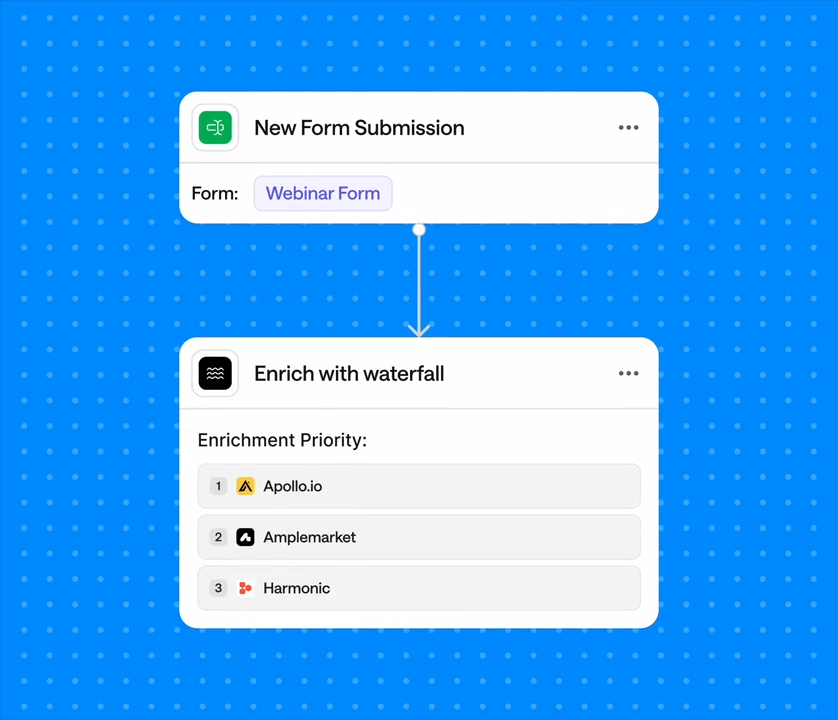
3. Automated fallback logic for broken flows
Every funnel breaks eventually — reps miss meetings, calendars disconnect, or leads ghost. What matters is: Does your system recover automatically?
You need:
- Backup rep routing
- Auto-rescheduling for no-shows
- Alerts for routing failures
Default handles this by design — every workflow path supports fallback logic for reps, calendars, and meetings, no patching required.
Book more meetings, protect your pipeline, and scale ops without adding headcount.Book your demo today.
Alternative to Chili Piper and HubSpot: Default
Chili Piper helps you book meetings. HubSpot helps you embed calendars. But if your funnel involves routing logic, data enrichment, ownership rules, and follow-up automation, those tools alone won’t cut it.
That’s why Default exists.
Default is an inbound orchestration platform purpose-built for RevOps and GTM teams managing high-velocity inbound flows. It replaces 3–5 point tools with one unified system where you can:
- Enrich leads in real time
- Route based on CRM logic, lead behavior, and fallback conditions
- Auto-book meetings with the right rep
- Trigger follow-ups or re-routing when things break
- Sync enriched data back to your CRM instantly
All without engineering. All inside a drag-and-drop canvas that mirrors your funnel — not just your calendar.
Default doesn’t just help you book meetings. It moves pipeline forward automatically.
Key features
1. Visual inbound orchestration
Default’s visual builder lets you orchestrate your entire inbound flow — from capture to booking — in one drag-and-drop interface. You can route based on CRM fields, enrich before assigning, and trigger follow-ups without writing code or jumping between tools.
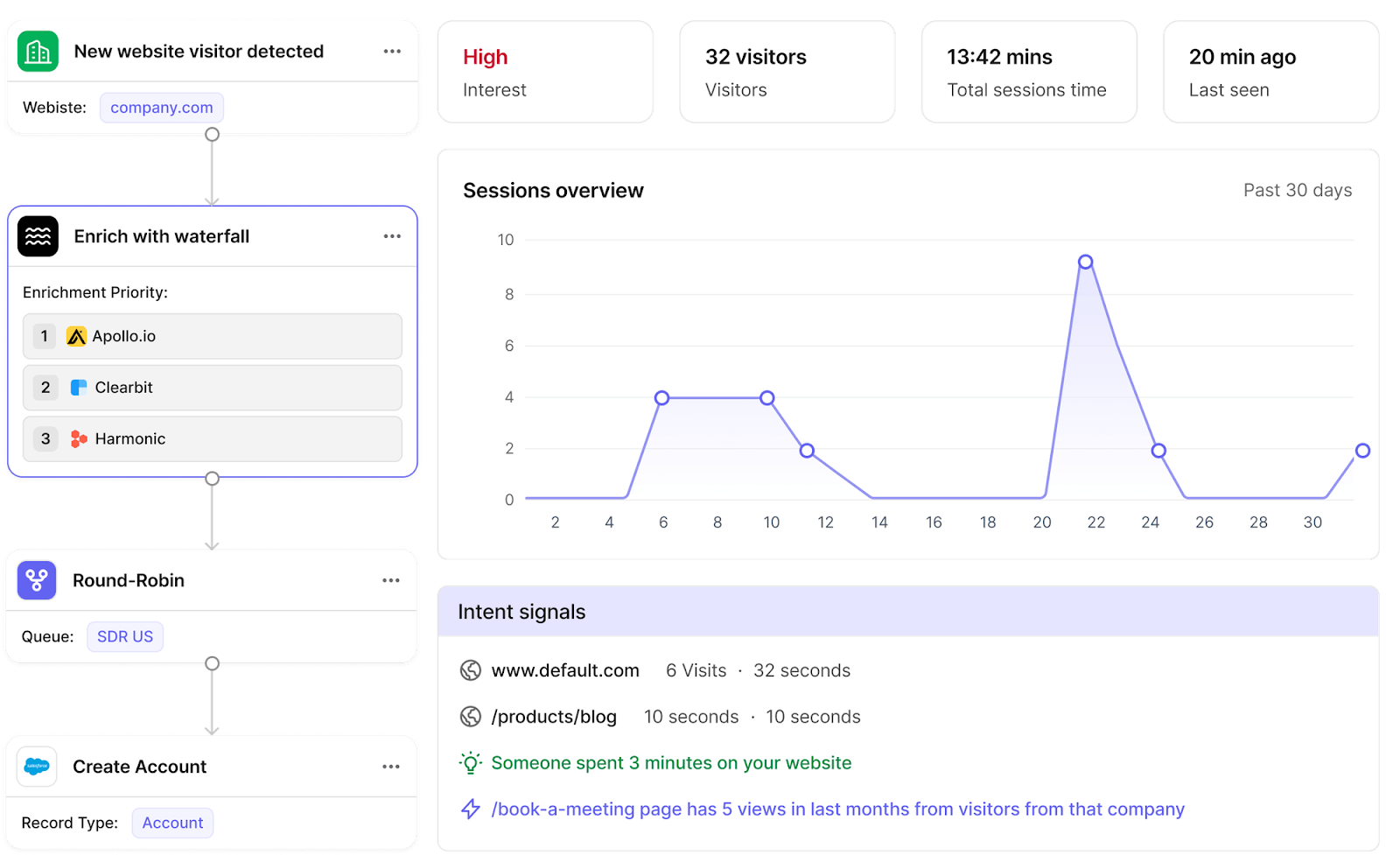
2. Real-time enrichment & CRM write-back
With real-time enrichment and deduplication running mid-flow, Default ensures you never route dirty data. Every lead is scored, enriched, and written cleanly into your CRM before routing logic executes — so reps work clean, actionable records every time.
3. Automated fallback & fail-safes
If a rep’s calendar is full, a meeting isn’t accepted, or a no-show occurs, Default triggers the next-best step automatically. Whether that’s rerouting to a backup, rescheduling, or triggering a Slack alert — your funnel doesn’t stall, and no lead gets lost.

Pricing
Default offers transparent pricing designed for RevOps teams that need control without complexity. You get predictable costs based on platform usage, seats, and enrichment — no hidden add-ons or multi-tool stacks to manage.
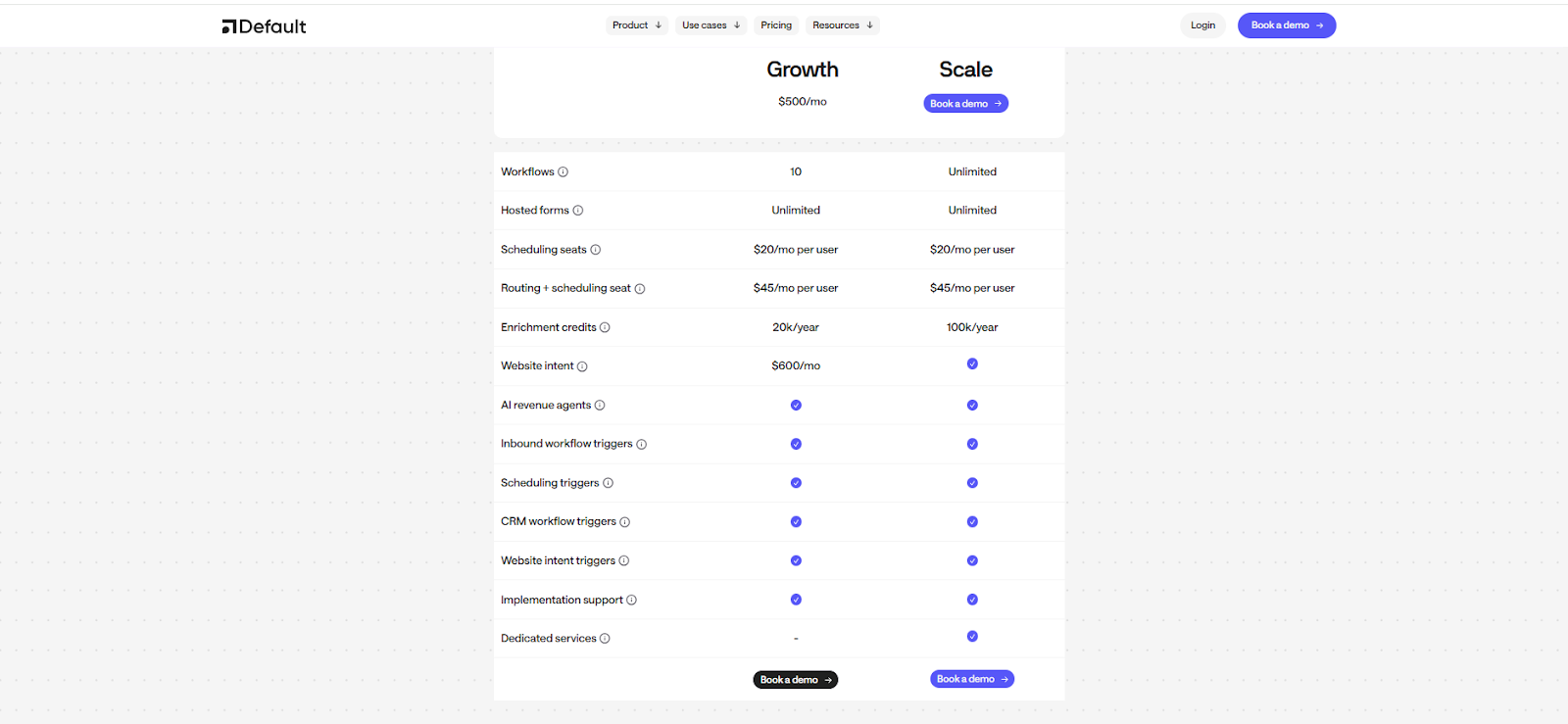
Where Default shines
- Full-funnel orchestration: One tool, all the steps — no Zapier, no duct tape
- Built for GTM speed: You can launch in days, not weeks. No surprise fees, no bolt-ons, no Salesforce Flow hacks
- Ops-native design: You control the logic. You see everything. You don’t need engineers.
Where Default falls short
- Not built for basic use cases: If you just need a simple booking link with no routing or enrichment, Default is more than you need.
- Takes thoughtful setup: You’re not just adding a tool — you’re replacing fragmented infrastructure. That takes a strategic mindset (and we help with that).
Customer reviews
“It takes the headache out of inbound scheduling and qualification. We're able to set qualification parameters so if someone signs up and meets our ICP, they can instantly book a meeting with a sales rep, eliminating the back and forth and saving us hours.
Plus, the way it integrates with our existing tools like Hubspot and Slack makes the whole process feel seamless. Our inbound conversion rate went up significantly thanks to Default!”
— Brandon P, verified G2 reviewer
“Our entire inbound engine runs on default.com, and we can't seem to imagine why anyone would not use this as a core tool in the marketing/sales stack!
The product fixes every possible problem you could imagine when handling inbounds - be it qualification, routing or tracking. Additionally, the fact that the entire product is plug-and-play makes endless customization a breeze. What used to take us hours in our inbound management process, now takes us seconds to achieve:)
Moving from a completely manual inbound process to default.com, especially when experiencing hypergrowth definitely helped us scale in the right way.”
— Pankaj S., verified G2 reviewer
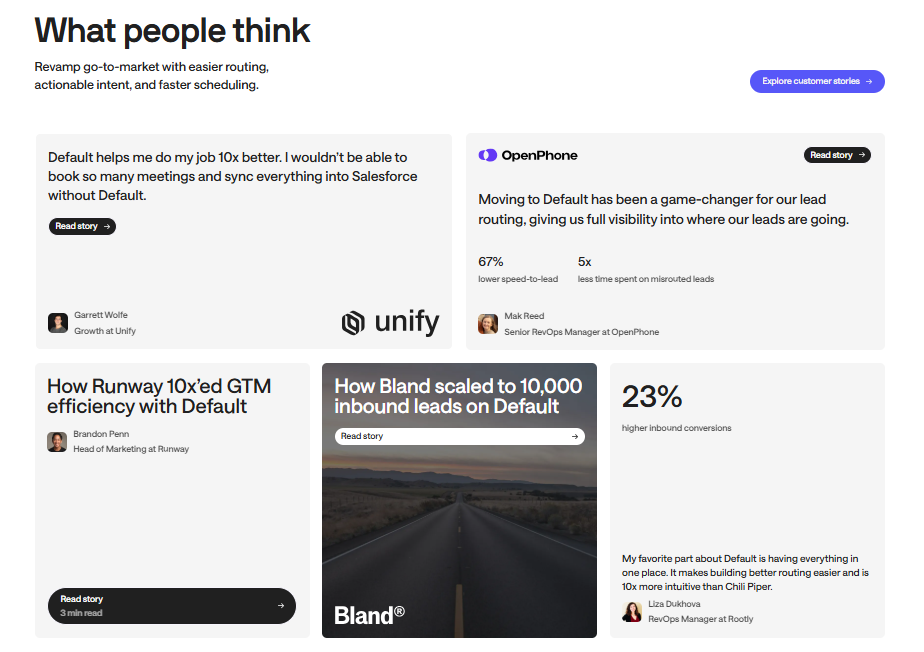
Who Default is best for
- RevOps leaders: Replacing fragmented routing, enrichment, and scheduling tools with one controllable system.
- Scaling GTM teams: Moving fast, managing multiple handoffs, and protecting pipeline without adding headcount.
- CRM-first operators: Running Salesforce, HubSpot, or Attio and ready to operationalize clean, object-aware routing logic.
Ready to replace point tools with a smarter, unified system?Book your demo today.
Why are you still managing five tools to do what one platform can?
Default replaces disconnected workflows — enrichment, routing, fallback, scheduling, CRM sync — with one RevOps-native system.
You get:
- Visual logic that adapts to your GTM strategy
- Real-time enrichment and CRM cleanup baked in
- Built-in fallback for no-shows, disconnects, and ownership gaps
- Faster GTM setup, with no engineering required
Stop patching. Start orchestrating.
Conclusion

Former pro Olympic athlete turned growth marketer! Previously worked at Chili Piper and co-founded my own company before joining Default two years ago.
Accelerate your growth with Default.
Revamp inbound with easier routing, actionable intent, and faster scheduling















.png)


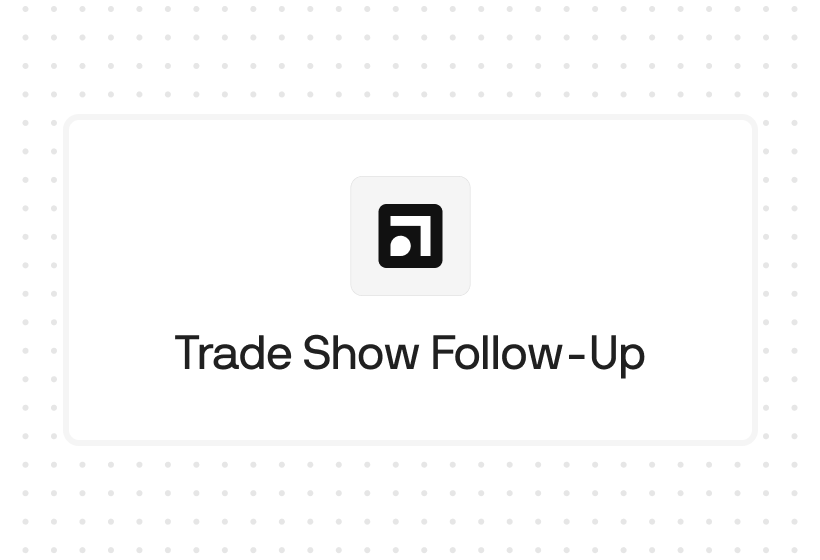
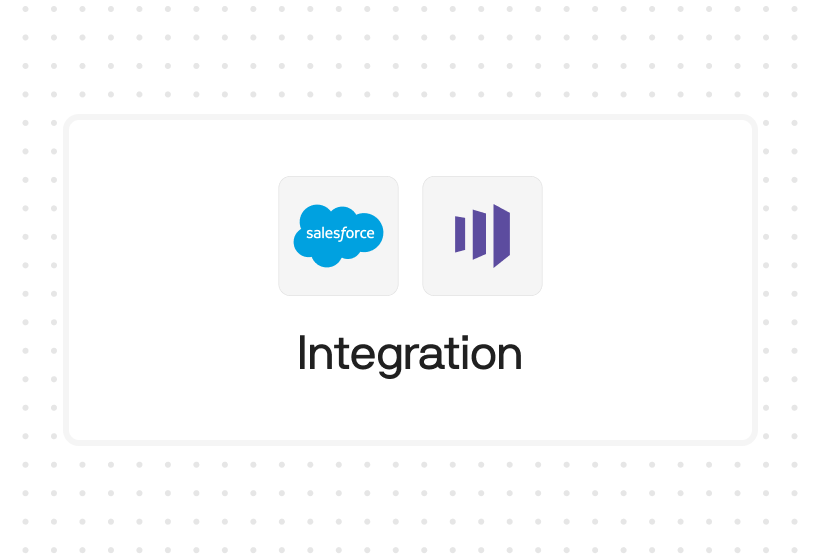




%201.svg)



.svg)





%201.svg)



%201.svg)

